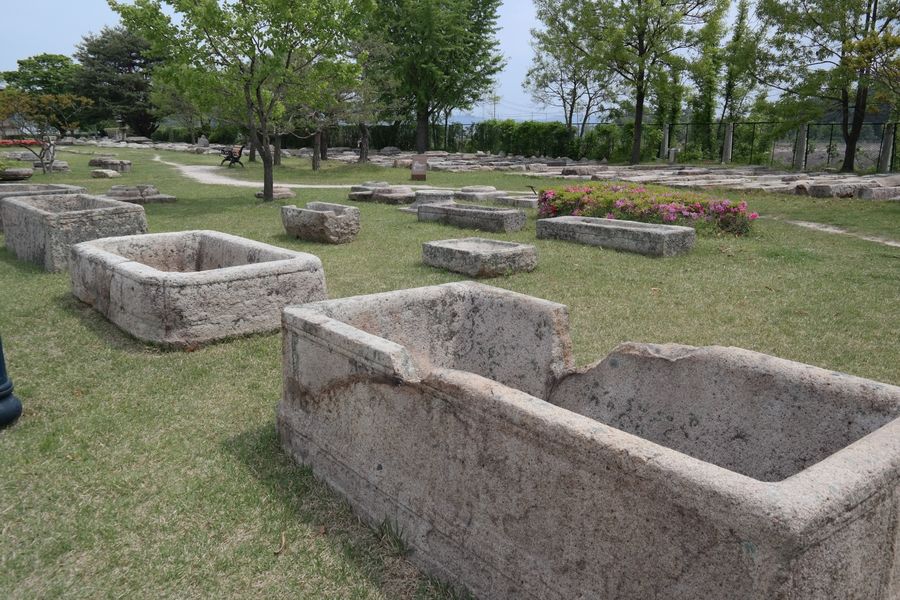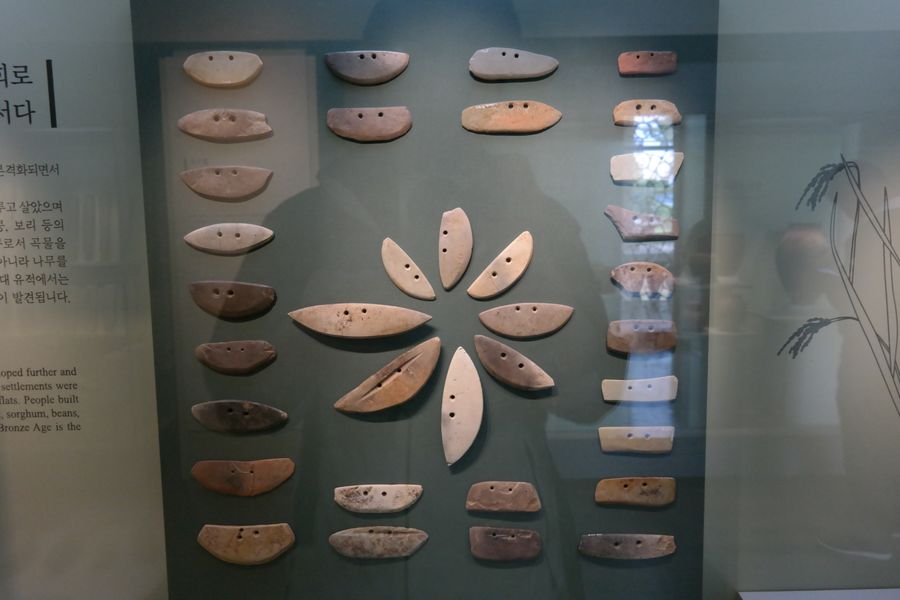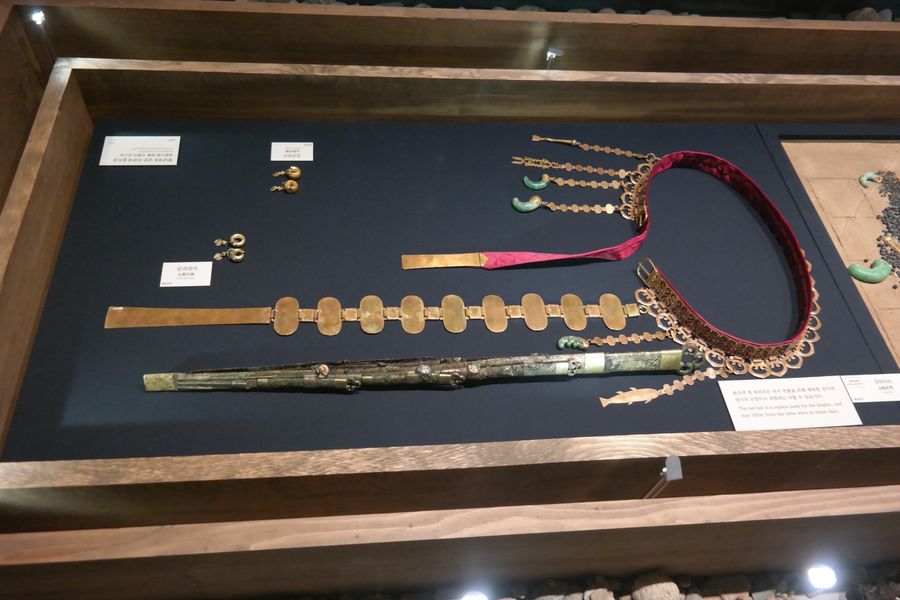-
Start
-
Daereungwon Ancient Tombs
-
Cheomseongdae
-
Gyochon Village
-
Gyeongju National Museum
-
Bulguksa Temple
-
Bomun Tourist Complex
-
Gyeongju Tower
-
Bunhwangsa Temple
-
Food
-
Finish
Gyeongju National Museum – Outside Exhibition 국립경주박물관
The first places I always look around first are museums, but at this Gyeongju trip, because the museum is located at the outskirts of town, we came here in the afternoon.

The Gyeongju National Museum is located at the front of Namsoan's north, the treasure place of cultural sites. It is a large museum with 13 pieces of national treasure, 26 pieces of treasure and about 8 million pieces of ruins. Currently the museum is open without any entrance fees, but you should step the small process to get the free entrance pass at the ticket box to go in.

The museum is divided into 4 buildings and there are multi-language guide devices for foreigners and there are also strollers and wheel chairs provided at the right side of the entrance. And at the first floor of 'Silla's History Building(Main Building)', there are lockers.

The museum provides exhibition interpretation from 10:00~12:00, 14:00~16:00 for people.
Those who want to listen to the exhibition interpretation should check the schedule in advance and visit, because the time is different depending on the days and the buildings.

When you pass the information desk, there is the large Beomjongru at the right side of Silla's History building. There is King Seongdeok Divine Bell(national treasure no.29), also called as Emille Bell because the sound of the bell is like a child's cry of searching for his/her mother.

King Seongdeok Divine Bell is the biggest bell of Korea, it's height is 3.75m and it was originally at Gyeongju Bongduk temple, which is a temple for the spirits of the kings. Then the bell was moved in to this museum in 1975.
By the way, there is a legend that a baby was offered when making the bell, because the bell's sound is very interesting like a child's cry. But according to the result of a scientific research, it turned out that the legend was just an rumor because phosphorus(P) wasn't detected, which is a component consisting the human bones.

At the back of the Silla's History building there is the real size replicas of Bulguksa Temple's Seokgatap(right) and Dabotap(left) displayed in the wide glade. But because it's not far away from Bulguksa Temple, there were not many people looking around them.
As a story after a while, it's a relif that I had seen Seokgatap at this place. (Currently~31 December 2014 the Seokgatap of Bulguksa Temple is under construction of disassemble.)

Behind Seokgatap and Dabotap there are stone structures(Water containers used to contain offered water in temples) supports of stone statues of Buddha, various foundation stones.

There is a very rusty and tall three-story stone pagoda standing near the managing building which is at the back side corner of the museum. It is the three-story stone pagoda of Goseonsa Temple where Saint Wonhyo had stayed.
The site of Goseonsa Temple was moved to the museum, because of the dam's overflow. And it is said as twins with the Gameunsa Temple Site three-story stone pagoda near the King Munmu's tomb at the east side.

This Avalokitesvara Bodhisattva statue is unique and bigger than other Bodhisattva statues, but it has a different story.
Until the 70's, the body part was in Namsan and the head part was in the museum, and an old man who remembered the Bodhisattva statue's unique appearance said the Bodhisattva statue was a one part. So since 1975, the Bodhisattva statue came back together to one piece.

The head part of this Bodhisattva statue was also found in Namsan after a storm passed through. According to the head's size it is assumed that the head would be very large, but it is made 4 by dividing for the beauty of distance for the believers who look up at the Bodhisattva statue.

There are surrounding stones of tombs and various decorations that are used on roof-stones displayed at the outside gallery.
Especially behind the Special gallery building, there are many ruined Bodhisattva statues layed gloomly waiting for tourists.
And there are many more exhibitionsoutside, so if you sightsee slowly around the museum, you can take a look at the many ruins.
Gyeongju National Museum – Silla's History Building(Main Building)

After taking a look around the outside gallery, we headed into the Silla's History Building. This building is the biggest one among the museum, and normally people visit here first.

When you go in the building, as most museums are, the ruins are classified as chronological. So the first ruins to come out was Crescent-shaped stone knives and Petroglyphs, those of the Stone age.

The representative ruin of Bronze era, Mandolinshaped bronze dagger(Liaoning-style bronze dagger). It is a ruin that I have seen familiar, so I moved on to look at the ruins that are more like Silla's.

The unique earthenwaresmade during the ProtoThree Kingdom Period(AC. 3C) or Silla era is the ones that are shaped like ducks or birds.
It is called as mould earthenware or Embossed type of vessel and it was used as alcohol bottles or water bottles and it's really shaped like birds.

Curved jades is an accessory made to attach as a decoration, jade carved in a sophisticated skill. It was usually used on silla's golden crown a lot.

There are many crownsand golden earrings and glass products that are from the west displayed in Silla's History Building.

Goguryeo's Bronze bowl & houmyeongbowlfound in Gyeongju Howoo Tomb, a Silla's ancient tomb.
'EulmyonyungukgangsangGwanggaetoJihoTaewang' is written on the bowl, helping us to estimate the relation of Goguryeo and Silla during the era of King Gwanggaeto the great.

The iron helmet is already rusty all over, but it still looks strong. It looks a bit different from other helmetsfrom the west or other eras.

The clay doll, a representative ruin of Silla. It is affective for having various funny faces and the free sexual expressions that helps us to assume the life of Silla's people.


And Hwangnam DaeChong golden belt(national treasure no.192) is also recovered, displayed. This belt was found in it's perfect shape from Silla's royal tomb.
Under the belt there are medicine box and fish, whetstone, Curved jades hung that are various representatives.t is told that after Hwangnam Northern mound of Hwangnam DaeChong's era(6th century) this kind of fancy funeral culture has vanished along with the chage of the society. So this ruin can be said that it's made in the most fancy times.

The horse's saddle with the decoration of thousand wings of Flatheaded borers we have seen in Cheomseongdae. The actual ruin is also sometimes displayed in the special gallery.

The golden tomb(national treasure no.191) that was found in Hwangnam DaeChong. It is decorated with 3 wooden shaped decorations at the round head rim and 2 deer horn shaped decorations hold tight with a golden nail.

The decorated a formal-dress sword is found in Daereungwon's king Micu's royal tomb and the red Ganettes that are used are not found in our country. The small Ganette used on the formal-dress sword is over 3carat. And it is said that Ganette over 2 carat is hard to find all over the world, even nowadays.
And king Micu's royal tomb's decorated formal-dress sword is the only one in the world to have the similar shape with the short sword from Borobo, Kazakhstan east Europe. Some researchers say that this formal-dress sword is effected from the Kelts from east Europe.

Martyrdom statue of Ichadon, who is an important person for Silla to accept Buddhism during king Beopheung. On one side, the picture of Ichadon is carved. It is said that white blood came out of his head when it was sliced.

Reliquary(Chaljubongi), the sophisticatedly made Hwangnyongsa wooden tower site. On the front and back side of the door, there is Inwangsang and Shinjangsang decorated and the other 3 sides there is a record of the details of how the Hwangnyongsa 9 floor wooden tower has been made, and the people who participated in.

At Gyeongju National Museum, there are many recovered ruins and national treasures/treasures and also ruins that are related to Silla and Gyeongju are displayed. So for me, the reputation is good that it is not boring, comparing to other museums that repeat the contents of the neolith era and Bronze era.
Gyeongju National Museum – The special Gallery
Next is the special gallery, where only the actual ruins are treated.

The contents of the special gallery are different every season, so it's dependable on you luck. Fortunately, when we had visited the contents were related to Cheonmachong, where a lot of ruins that worth like national treasures were found.

The part where several golden plate are connected are covered with gold. Each golden official hat(national treasure no.189) is one of the elite grave goods that represents the power of the leader. Instead of putting them on the head directly, they are estimated to be used as decorations to put on upper side of hats.

Golden bird wing-shaped golden crown decoration(treasure no 618), made to pin in front of the official hat, unlike official hats or golden crowns, these are found as tomb articles buried together.
This ruin is especially made with 45cm size of golden plate and the golden plate has a hole of dragon shape or grass vine shape. And there are more than 400 hooks on golden plates of each side, so it shows a very fancy look.

The recovered Cheonmachong's ruins when it was unearthed. This is just an replica to show the location where the ruin was found.
Behind are various Cheonmado including Cheonmachong's Cheonmado, but unfortunately taking photos is prohibited, so we just had to remember them with our own eyes.
Gyeogju National Museum – Wolji Gallery
Gyeongju reminds us of royal tombs. And many ruins are enearthed from royal tombs, but not all of them are found from royal tombs. Wolji, which is right next to Wolseong, also called Anapji is a lake where many ruins have been found.

But, because Wolji isn't a tomb, the most of the ruins are parts of buildings or articles for daily use, instead of the funeral articles of the high class.

What's more is that Wolji is filled with water, that the wooden ruins that were used in Silla kept their shape, thanks to the soft soil that is drowned in the water. It's very mystic.

Wolji is estimated as the best structure, because green-glazed gwimunwa(dragonface tile) is used, which is ingredients used on only the best artifacts. Wolji must have been a building related to the royal palace.

This Gold and bronze Dragonhead was found in a pair, and the inner side is empty with nail-hole at their upper side. By their appearance, they are assumed to be the decorations for the doorknob for a chair.

Several Gold and bronze devil mask doorknob decorations that are made in the same mold were found, and just like Gwimunwa, the embossment is very remarkable.

The 판불 that were found in Anapji are total 10, and only 2 are Buddha Triad form, and the rest of them are Sole format of the bosarwa statue as in the picture. In the bottom there is a point, so it must have been used to be attatched at somewhere.

Drinking dice that are made with Oak were also found. drinking dice is an amusement tool used in banquet hall, to make up the atmosphere. Hexagon is made of 8 sides, square is 6sides, and various missions are written on every side. It is similar to dice of nowadays.
Drinking dice make us able to assume the taste of art of Silla's royalty and nobility. And recently, there are breads called drinking dice bread, it's a ruin that is found in various contents in Gyeongju.

In Gyeongju National Museum, there is a children's museum in the underground floor of the special gallery, where various experiences are possible. The entrance is on the left, and it'll be a good chance for children to be interested in our history, if you're on a tour with children.

There is a café inside the Gyeongju National Museum. 'Dayeon' café sells drinks in a reasonable price, despite it's located in a tourist site. It is between the special gallery and the main entrance of the museum.

As said before, Gyeongju National Museum displays ruins of Gyeongju variously so it wasn't boring comparing to other museums. And the ruins that are in the textbooks were in the museum, boosting up our interest. But as an advantage and also a disadvantage, there were too many ruins that we couldn't look around all the ruins carefully. If I visit Gyeongju Museum next time again, I'll be in time f the material explanation time to listen to the details and look around.
We finished our tour of the displayed ruins and left Gyeongju National Museum. Because we had not enough time and we had to move on to the outside tourist sites, we didn't look around Silla art museum and headed towards our next destination. We will look around Silla art museum next time…!
Address: Gyeongju, Gyeongsangbuk-do inwangdong 76
Phone Number: 054-740-7500
Opening hours: 09:00 to 18:00 (19:00 on weekends) / March to December Saturday 21:00










